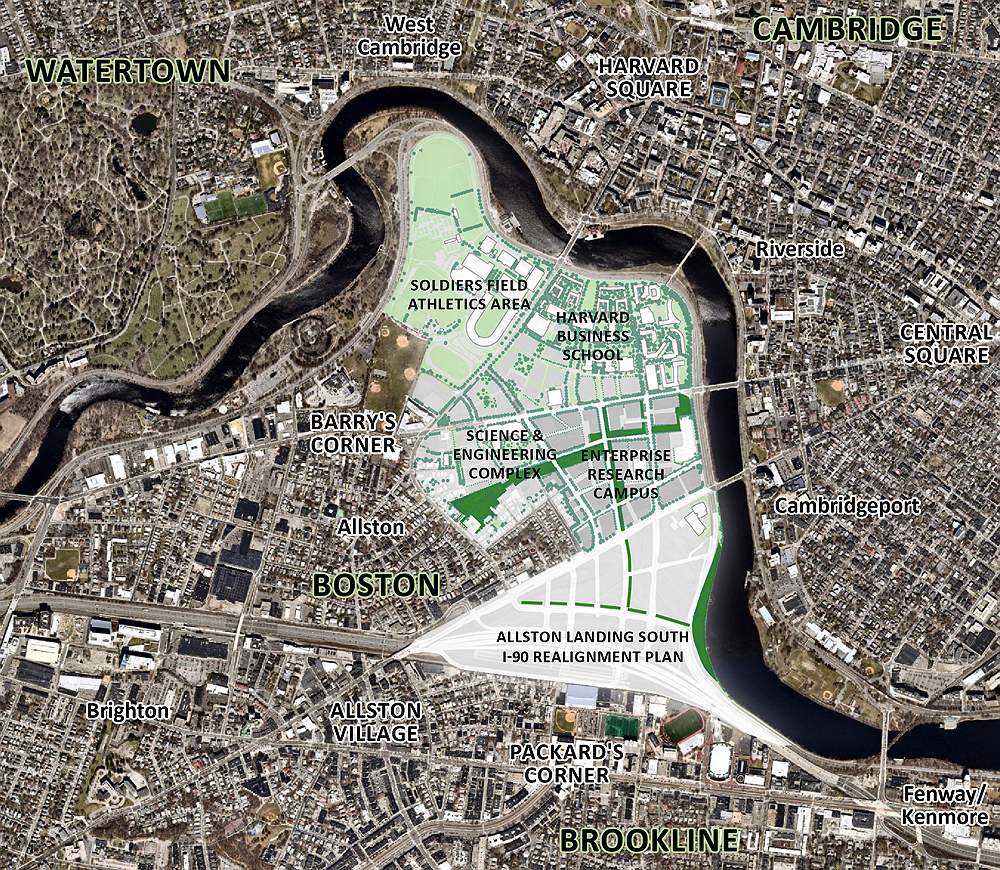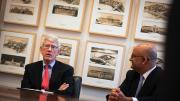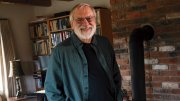The University today unveiled a nascent Allston land company (ALC), a wholly owned subsidiary with a new structure and leadership—notably, former Massachusetts Port Authority chief executive Thomas P. Glynn, who will be CEO—focused on Harvard’s plans for commercial development on its landholdings south of Harvard Business School. The new entity separates development within the 36-acre enterprise research campus (ERC) from future academic growth that may follow the science and engineering complex now under construction for fall 2020 occupancy, although Harvard hopes that the activities will be complementary. In the news announcement, President Lawrence H. Bacow said:
Allston will be Greater Boston’s next epicenter of research, discovery, and innovation, and we want to speed progress toward that goal. The new land company will focus the University’s efforts to strengthen and expand partnerships throughout the region, especially among our peer institutions, local hospitals, and businesses and investors. Its work will have a long-lasting impact on the development of our campus—and the broader community—and spark and shape future enterprises that will change the world in ways that none of us can predict.
ALC’s efforts will focus initially on the 14 acres within the ERC, shown on the map, for which Harvard’s development plans received Boston regulatory approval earlier this year. They encompass 900,000 square feet of new development: two office/laboratory buildings; a hotel and conference center; and a residential tower. At the southeast corner of the parcel, Harvard is well along in erecting a district energy plant designed to serve the commercial and academic campuses.
 The new land company focuses on developing the 36-acre enterprise research campus, the current commercial portion of Harvard’s Allston landholdings.
The new land company focuses on developing the 36-acre enterprise research campus, the current commercial portion of Harvard’s Allston landholdings.Image courtesy of the Harvard Planning Office
ALC is the first visible result of Bacow’s concerted work on Allston—the first University priority he mentions in many contexts. The announcement comes as discussions are also under way with neighboring institutions like MIT and Boston University—with whom Bacow has said he is exploring numerous partnerships—about jointly creating graduate-student and faculty housing and, perhaps, life-sciences research facilities.
Management Prowess
The new organization brings to its work an infusion of existing and fresh expertise. Bacow himself served on the Harvard Corporation’s facilities and capital planning and finance committees before becoming president, so he was already steeped in Allston’s challenges and potential. Less commonly known, decades earlier, just when the University was first assembling properties in Allston, he pulled together diverse parts of MIT—his own department, urban studies and planning; economics; civil engineering; architecture; and the Sloan School (the business faculty)—to create the institute’s master’s degree in real-estate development.
Dean Nohria. The chair of ALC’s governing board is Harvard’s leading figure bridging the academic mission and Allston development: Nitin Nohria, HBS dean since 2010. He has effected the robust expansion and redevelopment of his school’s executive-education campus (Tata Hall, Chao Center, and other facilities) and its new conference and convening center (Klarman Hall). Moreover, Nohria has:
- spurred development of the three-site, Harvard-wide iLabs along Western Avenue—a key to the “innovation district” DNA the University is promoting for the adjacent commercial development;
- played a role—perhaps the central one—in encouraging alumnus John A. Paulson, M.B.A. ’80, to underpin engineering and applied sciences with a $400-million gift of unrestricted endowment funds; and
- then promptly set about building bridges linking the HBS faculty and the engineers and applied scientists so they will be well along in academic collaborations long before the latter move across the Charles River to their new home a little less than two years from now.
He is also an MIT Sloan Ph.D., so, like Bacow, he has ties to that potentially important partner institution; and his faculty members and alumni encompass deep and wide knowledge of real-estate development. Keeping Nohria engaged is a significant boost to the Allston program.
In the news announcement, he said:
The Boston area has always been an extraordinary hub of innovation, and we are now presented with an opportunity to add to this amazing innovation ecosystem. I feel privileged to be part of the group thinking about the future of Harvard in Allston, and ensuring that we’re continuing to contribute to the economic and intellectual vitality of the region. This is a truly unique opportunity, and we’re committed to getting it right.
Amplifying in a Harvard Gazette interview, he said, “Our goal is to invite into the Enterprise Research Campus companies that have a research and intellectual intensity. It’s not called the commercial zone, it’s called the Enterprise Research Campus, and I think the word ‘research’ should not be taken lightly. It will become quite intimately tied to the research and teaching enterprise of Harvard University.”
He also talked about the initial 14 acres along Western Avenue as the first locus of development, during the next five to 10 years, extending from the Continuum apartments and retail spaces at North Harvard Street, past the engineering complex, and to the ERC buildings. Later, he said, “Once the turnpike project is completed, we will abut Boston University”—opening up possibilities, in “some 20- to 30-year future,” for integrated development accessible by foot and mass transit.
CEO Glynn. Equally significant is the appointment of Glynn as ALC’s CEO, effective next Monday. In August, he announced that he would step down as CEO of Massport effective this November, a year before the conclusion of his contract; he did not, at the time, disclose future plans. At Massport, Glynn spurred growth of Logan Airport and revitalization of Boston’s port, development of an anchor hotel near the Boston Convention & Exhibition Center, and unending commercial construction in the booming waterfront Seaport district. If those developments—involving regulatory approvals, some public financing, managing political and neighborhood relationships, and project oversight—were not in themselves attraction enough for Harvard, Glynn was previously:
- chief operating officer at Partners HealthCare, parent to the University’s two biggest affiliated hospitals (and a potential research partner in Allston);
- general manager of the Massachusetts Bay Transportation Authority (which will be involved in any mass-transit options for Allston, like the proposed West Station—the key to Harvard’s future commercial development, beyond the current 36 acres, on the even larger Allston Landing South properties south of the Massachusetts Turnpike’s Allston Interchange, once it and the associated highway are rebuilt—see map); and
- a lecturer at the Kennedy School (between his MBTA and Massport jobs).
He has also held positions in the state and federal governments; at Brandeis; and at Brown University—and, to top things off, was an external member of the Corporation’s facilities and capital planning committee.
It almost defies the imagination to conceive another figure active in Greater Boston and Massachusetts government who combines current expertise in so many aspects of effecting development in a virgin territory like Harvard’s Allston commercial zone—and who understands academic institutions as well.
In the news announcement, Glynn said:
The possibilities of what can occur here will have deep and lasting impacts across every sector of this region—from scientific discoveries, to economic investment, to critical infrastructure improvements. As a former member of the [Corporation committee], I had the chance to follow the progress that’s happening in Allston. It is a great opportunity to work with great people, and I can’t wait to get started.
As first priorities, he said in the Gazette interview, he and Nohria are refining the ALC structure, staffing, and budget. The board of directors is still being populated, but is expected to include Corporation members, representation from the institutional planning staff, and outside experts; all appointments will be made by the Corporation.
The Allston Backstory
Creating the ALC is the third effort to accelerate development of the acreage Harvard assembled beginning in the 1980s.
After President Lawrence H. Summers unveiled plans for a vast academic campus with millions of square feet of new research facilities, Christopher M. Gordon, fresh from overseeing major reconstruction of Logan Airport, joined the University in 2005 as chief operating officer of the Allston Development Group, charged with effecting the campus construction swiftly. During her first official day in office, in July 2007, President Drew Faust met with Gordon to review progress on those plans. When financial circumstances dictated that Harvard rethink both the pace of Allston construction and the broader plans, he departed in mid 2010.
After the revised institutional master planning was effected earlier in this decade, and provision was made for the enterprise research campus, Steven D. Fessler was appointed to direct the work in April 2016. With a background in real-estate investment and development, he seemed ideally suited to identifying commercially viable ideas that complement Harvard’s academic aspirations in Allston, and in creating partnerships with private developers to get agreement on feasible projects—and move them toward realization. The four structures permitted in the 14-acre parcel, and the associated parking, would jump-start that development. His office will apparently be folded into the ALC.
The new entity—the third round—sharpens focus on commercial, as opposed to academic, development and does so with a high-octane infusion of expertise in the arrival of Glynn as CEO, versed in the political, financial, and regulatory processes entailed. As Nohria put it in the Gazette conversation, “[H]e’s someone who’s done amazing projects in this city. It’s rare to find someone who’s worked in every institutional setting—with the major hospitals, the major universities, with the state itself. Tom brings a unique set of capabilities and has seen this from all different angles.”
Looking Ahead
It is possible that President Bacow’s separation of commercial from academic development is meant solely to jump-start the former. Or perhaps he also is pushing ahead academic, campus-related developments that can proceed on a faster schedule, too, if management and oversight are separated from the different requirements for commercial development. Today’s announcement does not speak to that point.
There are several reasons that might explain the priority given now to ALC’s mission.
First, Fessler’s efforts to secure development partners for some or all of the projects slated for the initial 14-acre ERC parcel—or to proceed on faculty or graduate-student housing for the residential structure—may have ripened.
Second, the work of Fessler and of Shaun Donovan ’87, M.Arch.-M.P.A. ’95, who joined the Allston staff in 2017 as part-time “senior strategist and advisor to the president on Allston and campus development,” may have put the challenges and opportunities in a more favorable, feasible context, enabling the University to proceed once a new president determined to do so. Donovan was director of the White House Office of Management and Budget from 2014 to 2017 and secretary of the U.S. Department of Housing and Urban Development (HUD) from 2009 to 2014, following diverse responsibilities in housing and community development in New York and the federal government, bringing those helpful perspectives to the considerable work at hand.
Third, competing developments in Greater Boston are proceeding at a torrid pace—particularly on MIT’s Kendall Square properties, and surrounding developments, where life-sciences and technology companies have seemingly insatiable demand for more space; and in the Seaport, where, to cite just one example, Amazon recently committed to a multi-hundred-thousand-square-foot building for 2,000 employees, and an option for a second. The adage about striking while the iron is hot is not irrelevant: Nohria’s reference to “inviting” tenants for the ERC may indicate that the University feels it is playing from a position of strength under current conditions. But at some point, the market may cool—interest rates are rising, and property values are softening. If Harvard were left with vacant land in its first ERC phase, and then had to await the reconstruction of the turnpike and arrival of mass transit for years, or decades, for tenants who seek room to grow in the future, it could be facing a long wait.
Fourth, in strictly monetary terms, the University is holding land it values at $969 million in its most recent financial statements—an asset, outside the endowment, on which it is presumably earning little, if any, return. At a time when the endowment itself is being remade wholesale to improve lackluster returns, holding land for future use may have become too much of a luxury. One of the most valuable assets in MIT’s investment portfolio is its Kendall commercial properties. (Similarly, Princeton and Stanford benefit financially, and in other ways, by owning commercial office/research parks near their campuses.)
Perhaps by happy coincidence, Harvard Management Company’s decision to reduce the endowment’s real-estate holdings somewhat diminishes the University’s exposure to real estate overall, making it a more comfortable proposition to monetize some of the Allston property. Since the rethinking of Allston earlier this decade, the plan has been to reduce University exposure to, and investment in, developing the nonacademic parcels by cleaving off the enterprise zone—and enlisting private partners to undertake the actual development, perhaps while leasing the underlying land from Harvard or providing other financial compensation.
Today’s announcement of ALC represents a step forward on at least some, and perhaps several, of these priorities, early in Bacow’s new presidency. In the Gazette article, he amplified his views expansively:
We educate students, we generate new knowledge, and, through both activities, we seek to create a better world. I think the Enterprise Research Campus gives us an opportunity to accomplish all three of those objectives at a higher level.…
I think it’s going to bring enormous energy to Allston and to the academic campus in Allston. It will bring different people. It will bring different activities. It will help to bring housing, retail, and other functions.
Over time, it will prove to be an amplifier for the research that we do in Allston, because it’s our intent to try to recruit idea-intensive businesses to the Enterprise Research Campus that have a natural synergy with the scholarship that’s going on by our faculty and students in Allston.
Read the University announcement and Gazette article here.









